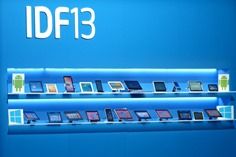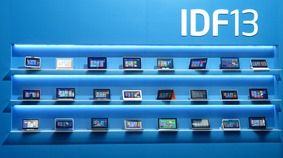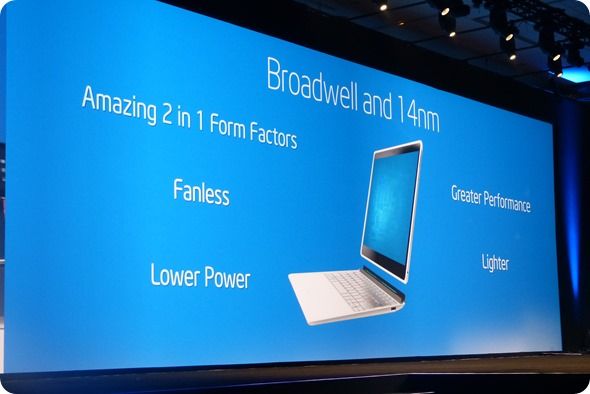The Ultrabook project has been solely responsible for turning round the PC design and engineering business and by that I mean reducing cost and introducing design flexibility that allows OEMs to respond to changing customer demands. The Ultrabook project forced tighter integration of components on a smaller motherboard, reducing the number of upgradable/serviceable components and removing nearly all electro-mechanical parts. It drastically reduced the thermal energy generated by a typical loaded motherboard and introduced new heat-reduction technology. The combination of small motherboard, fewer options and lower thermals led to convertible and 2-in-1 devices which are set to become the post-PC solution. They offer a dynamic range of usage that beats any other design out there.
Cost is still an issue though and with Baytrail, OEMs can use this new knowledge to build Ultrabook-like products at much lower cost. Where does this leave the Ultrabook?
At IFA and IDF over the last week we saw that technologies and techniques from the Ultrabook project are being used in Baytrail-based products where they combine with features, sizes and battery life that meets and exceeds that of ARM-based tablets – the big sellers. For the first time we’re seeing desirable low-cost 2-in-1’s and desirable low-cost Windows tablets. $349 will buy you a Baytrail-T based 2-in-1 with 11 hours of battery life, 1KG in weight and enough power to run Windows 8.1 smoothly. $299 is likely to be the price-point for a good 8-inch ‘do-it-all’ Windows tablet.
Currently, 2-in-1 Ultrabooks reach down to around $650 and offer more processing power but at weights of 5lb, the consumer is going to be put off. In terms of consumer-friendly products, Baytrail is better positioned than Ultrabooks.
Where does this leave Ultrabooks? What unique position does the Ultrabook hold? What purpose does the Ultrabook project have?
Unique markets remain for the Ultrabook and it’s all about ‘best-in class.’ At the top we have business Ultrabooks like the Lenovo Thinkpad range. Then we have gaming Ultrabooks like the ASUS Zenbook Infinity. We have basic but high-power clamshells that offer desktop-like performance for small businesses, developers, video editors and other creation-focused customers. Convertibles with digitizers are in the Ultrabook space. As for 2-in-1’s I’m happy to say there’s space for them too. We’ve seen 780 gram Y-Series tablets over the last week which means you don’t have to compromise on performance as you do with Baytrail. With next-gen Broadwell (2014) we’ll see Ultrabooks offer huge performance advantages over Baytrail but with few of the compromises.
Baytrail is the best fit in the emerging 2-in-1 category. Entry-level laptops based on Baytrail will offer best-price, consumer targeted solutions that Ultrabooks and other Core-based solutions can’t but it’s quality and advanced technology you need for a productive, secure solution and Ultrabooks remain reliably the best-fit for that. More importantly, the Ultrabook project continues to be critical for the future development of the PC.
Our sister site, UMPCPortal, covers, almost exclusively, Windows 8 tablets and mobile solutions.














I really wish manufactures would focus on making the best laptops they possibly can. Leave tablets as a second stand-alone category.
All of these detachables, convertibles, flip arounds, flip overs, whatever … are destined for failure. In a few years we will look back at them & laugh at a PC industry that seems desperate to differentiate with inefficient gimmicky designs.
Where is a Baytrail version of something like the Zenbook Infinity/MBA? Besides performance, it would have advantages in thinness, weight, battery life, fanless design, price & could potentially be the best overall consumer device on the market.
Or … where is a best-in-class Surface/Nokia Haswell/Baytrail pure laptop?
MS needs to stop chasing Apple/Google down yet another category, years too late (again), that they will ultimately fail at. It was mp3 players, then modern smartphones, now tablets.
I fully agree with you Eshirl. Where are the 1.8 to 2 Kg 15 or 16 inch laptops with 16:10 IPS high ppi displays without big ugly bezels and which can last at least 8 hrs of workload? The new MBP doesn’t count since it is impossible to upgrade or repair easily.
Check out the Lenovo zbook 14, they are trying to get there
I respectfully disagree with your prediction. I can hardly wait for a full blown windows system on an 8″ detachable form factor that weighs in at less than a pound. There are more like me as well
Apple got it wrong. Developers will port over apps that are meant for windows users onto Android.
You say that now but wait until you try using the desktop on an 8″ touch device, even the simplest things you take for granted will become a HUGE chore. Within a few hours you’ll be begging to have a keyboard & touchpad back.
You can always tell the old timers who actually used UMPC’s & remember just how bad the experience was versus the idealistic newbies who think an all-in-1 solution is actually possible.
I agree. I’d like to see more 8″ Windows 8 tablets.
@rescii
I’ve used Windows 7 and 8 on 5″ – 8″ screens. Yes, it’s harder to use than on a large screen but then again, doing anything on a small screen is harder even on Android. The disadvantages are far outweighed by the full desktop OS. I guess that really depends on what you do though. If you don’t make use of any desktop Windows advantages then, obviously, you should get an iPad or Android tablet.
Also waiting on a new 8 inch tablet with windows 8.1 :D, preferably Sony, but I doubt they will go that low end.
I agree that Baytrail-T is ideal for mainstream convertibles but ONLY if Intel has allowed WIDI or Miracast on them. The screen sizes are just too small to be meaningfully productive; what is the point of having an x86 capable Baytrail chip if you can’t run your x86 apps and productively multitask on them?
-This is the brand promise of Windows and a 2-in-one; if Intel hamstrings productivity by limiting screen size and preventing Baytrail-T devices from supporting multiple external monitors, they’ve dramatically dropped the ball again. They keep holding back Atom, which should be the modern mainstream x86 CPU to try and artifically make room for the ridiculously overpriced core CPUs; they’ve made HUGE strides on Perf with Baytrail, but if you can’t be productive with multi monitors and you’re limited to a tiny screen, what’s the point of having a Windows 2-in-1 at all?
Adam
BayTrail looks really promising. A cheap tablet, thin and light, running Windows 8, with enough power to multi-task, with a decent battery life, and the possibility to connect to an external monitor. That looks really good.
I wish Intel had allowed it to connect to more monitors. But that would require a better video card, probably.
And Intel has to earn some money. It still has to sell its higher-end processors to somebody. Intel won’t give up its US$ 999 chips in favor of US$ 140 ones…